Cooking with edible oils: Part I, Oils as cooking ingredients and dish accompaniments
Cooking: general and oil-mediated – an overview: Our cooking modes are any one or a combination of some of the following:
- Cooking by boiling is essentially heating food in direct contact with water, e.g. rice, khichadi, Rajasthani gatte. Par-boiling of potatoes, blanching of tomatoes and spinach and cooking of kheers, porridges, firni, chickpea flour mass for Gujarati ‘khandvi’ or ‘patavadi’, daal making etc are versions of boiling.
- Dry roasting, e.g. peanuts, fennel seeds, dry spices before grinding, aubergine (brinjal, eggplant) for bhartha.
- Baking, e.g. bread, biscuits and cookies, Gujarati handvo, ‘western tray-bakes’, naan.
- Deep frying, e.g. samosa, pakaude, papads, French fries.
- Shallow and smear/film frying, e.g. cutlets and patties, dosa, chille, uttapam.
- Stir frying, e.g. daily vegetable dishes, western ‘stir fry vegetables’, many Chinese noodle-rice-veg dishes.
- Air frying – a fad, e.g. air fried snacks.
- Hot plate roasting or baking, e.g. daily roti, paratha.
- Evaporative concentration, e.g. rabadi (domestic condensed milk), Gujarati sweet dishes for meals. (Ref. post 9, Some compelling cases for food processing: Part III, Dried milks). Professional chefs call this ‘reduction’.
- Oil/fat-assisted roasting as in upama and suji halwa or sheera.
- Miscellaneous, e.g. soups, salads, juices, grilling, grinding etc.


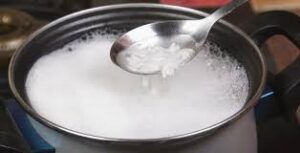
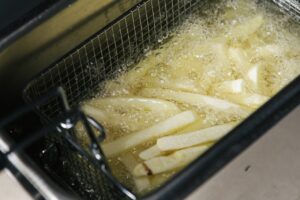
Interestingly, rice and plain khichadi are the only mainstream dishes that end up on the plate without a brush with an oil or ghee. And then too, they must engage with an oil or ghee or a dish containing them, to enter your mouth! Note that when oil is used, it either helps cooking by mediating in heat transfer (all frying and oil-assisted roasting as in upama and suji halwa or sheera) or as an ingredient in the dish e.g. stir-fried vegetables. Nuts and milk and its products contain oil or fat. Oil/fat sometimes accompanies a ready-to-eat dish e.g. bread-butter, Gujarati dhokla with groundnut oil, South Indian dry chutney powders ‘moistened’ with oil.
In this post, let’s focus on modes of cooking in which oil has no heat transfer role.
Oils as accompaniments to ready-to-eat dishes: Unnoticed, oils sneak in directly with ready-to-eat dishes and as garnishes, toppings and enrichers of eating experience :
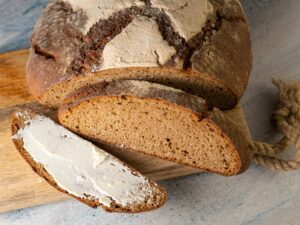 Butter/ghee on bread, versions of roti, Rajasthani bati, bowl of daal, cooked rice, khichadi, aamras.
Butter/ghee on bread, versions of roti, Rajasthani bati, bowl of daal, cooked rice, khichadi, aamras.- Unrefined groundnut oil with Gujarati dhokala, handvo, khaman.
- Unrefined coconut/groundnut/sesame oil in South Indian chutney powders.
 Cream on fruit platters, ‘punjabi’ subji dishes, daal makhani, lassi.
Cream on fruit platters, ‘punjabi’ subji dishes, daal makhani, lassi.- As the ‘plastic’ (spreadable/extrudable/pipeable) main ingredient of icing on cakes.
Their main non-nutrtional purposes are: mouth-feel, richness, lubrication, flavor, visual appeal. Obviously, our body takes no cognizance of why they came in; it simply digests and metabolizes them. (Ref. the 4 Metabolism posts for more details.)
As shortening in baked wheat flour dishes: (Ref post nos. 18, 19, 20 on edible oils and their physical / physiological functions).
 The problem of leatheriness of whole wheat flour dishes: When doughs are mixed with water and kneaded, a stretchy, thready protein called gluten is formed. Important: wheat flour, water and kneading are all prerequisites. It provides ‘strength’ to the dough i.e. the dough can be stretched and, when it expands while baking, it is strong enough to not collapse. This is applicable mainly to wheat which is the main source of gluten. Interestingly, gluten extracted from wheat flour is available commercially. Its hydrolysed form which is the main natural source of glutamic acid – an amino acid – is sometimes used as a flavor enhancer in savory dishes to avoid adding ‘Mono Sodium Glutamate’ or MSG, commercially called Aginomoto. It is a somewhat tainted but more effective and popular flavor enhancer for savory dishes/products.
The problem of leatheriness of whole wheat flour dishes: When doughs are mixed with water and kneaded, a stretchy, thready protein called gluten is formed. Important: wheat flour, water and kneading are all prerequisites. It provides ‘strength’ to the dough i.e. the dough can be stretched and, when it expands while baking, it is strong enough to not collapse. This is applicable mainly to wheat which is the main source of gluten. Interestingly, gluten extracted from wheat flour is available commercially. Its hydrolysed form which is the main natural source of glutamic acid – an amino acid – is sometimes used as a flavor enhancer in savory dishes to avoid adding ‘Mono Sodium Glutamate’ or MSG, commercially called Aginomoto. It is a somewhat tainted but more effective and popular flavor enhancer for savory dishes/products.
In absence of any oil or fat (immiscible with water as you know by now) in the dough, the gluten strands tend to stick to each other making the product leathery. This is further compounded by the gradual, inevitable ‘retrogradation’ of starch (ref post no. 28: Diabetes, the creeping, corrosive curse) in the grain which is essentially slow release of water trapped between starch threads causing hardening of the product. This is obviously independent of gluten. Now you know why stale bread or roti is unappetizing.
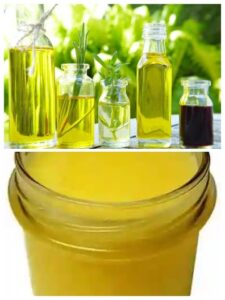 What are shortenings?: To arrest gluten strand elongation and networking, oil or fat is included in the dough which prevents adhesion of gluten strands and hence ‘shortens’ them with the effect that the baked product is tender and hardens less on keeping. In this case, the added oil or fat is a ‘shortening’. Though shortening the dough by addition of oil during kneading is classical, oils or fats are considered shortening agents in all cases e.g. you don’t need shortening in puri’s for immediate consumption.
What are shortenings?: To arrest gluten strand elongation and networking, oil or fat is included in the dough which prevents adhesion of gluten strands and hence ‘shortens’ them with the effect that the baked product is tender and hardens less on keeping. In this case, the added oil or fat is a ‘shortening’. Though shortening the dough by addition of oil during kneading is classical, oils or fats are considered shortening agents in all cases e.g. you don’t need shortening in puri’s for immediate consumption.
Crisp (or khasta) puri’s as stored snack are usually prepared with minimally kneaded doughs containing less water and gluten (wheat flour partly or fully replaced with refined flour or maida, sometimes with addition of semolina or suji) and shortening then almost totally arrests gluten strands with loosely held starch granules providing crispness. Salad dressings containing oils do not shorten the salads because there is no gluten there. (Ref post no 18 on physical functionalities of oils).
Liquid, solid, plastic and pourable shortenings:
Liquid: Functionally, shortenings work best when liquid because they can spread easily in the dough to cover all gluten. This is why refined or unrefined oils are best for daily cooking of versions of roti and paratha for meals with whole wheat flour. Gluten is a welcome protein (despite gluten intolerance in some people) in vegetarian diet and shortening makes it acceptable. Interestingly, any kind of roti (fulka, tandoori roti, rumali roti, paratha, kulche, bhature) at home for immediate consumption (‘fulka straight off the tawa’ or garama-garam roti, of olden days) is not exposed to high temperatures because of presence of water. Hence using high IV (even linolenic) oils as shortening is quite safe. Of course, using such high IV oils for ‘kachcha tel’ applications is the safest.
Solid: Granular ghee and vanaspati, as such, are solid shortenings sometimes preferred for snacks to be stored because of their superior oxidation resistance and flavor. (Ref post no. 17, Edible oils: an introduction for the connection between the physical state – solid or liquid – of the oil/fat, its IV and oxidation resistance). Most of ghee and a lot of vanaspati, actually melt during kneading because of body heat providing some optimization between shortening effectiveness and oxidation resistance. Such doughs tend to be low in water and gluten and hence shortening requirement is limited in any case.
Plastic: This is a name given to fats that have extensive networks of small, adhesive crystals trapping some oil within them. They are so called because they easily ‘yield’ (i.e. don’t resist) when force is applied to them as in butter at 30 deg C being spread on a slice of bread. Their most outstanding functional feature is ‘spreadability’. It is exploited (apart from the ubiquitous bread-butter and muska pao) in a series of short baked products like the western short bread, croissants, flaky pastries etc. Their superior oxidation resistance (stemming from low IV) aids in giving them a long shelf life which is expected from them.
Pourable: It is easy to see that they combine the liquidity of oils with oxidation resistance of solid (low IV) fats, the latter obviously toned down by the presence of liquid (high IV) fraction. Largely a western concept, they have faced serious threats from increasingly ubiquitous palm oil which can be (and is) a natural, pourable shortening at around 35 deg C. All homemakers have noticed that anhydrous milk fat (desi ghee) tends to be a pourable shortening when it cools gradually to ambient temperatures of about 30 deg C from a molten state. When hydrogenation was alive and kicking, making low TFA pourable shortening from partial, controlled hydrogenation of soybean oil was a delicious challenge. Even today, controlled and externally uninterruptedly tracked soybean oil hydrogenation to deliver the prized nutraceutical – Conjugated Linoleic Acid (CLA) – should lead to a pourable shortening! It obviously requires hydrogenation to be stopped at or near the CLA maxima – a technology that can be developed relatively easily.
 As salad dressing: Salads, whether fruit or vegetable based, are rich in dietary fiber, vitamins, minerals, plant pigments and antioxidants but water is the main constituent. Now, the micronutrients can be either water or oil soluble; oil in the dressing makes micronutrients in salads more bio-available. Cream or condensed milk over fruit salads and oily dressings over vegetable salads is, therefore, a good idea. The simplest salad dressing at home is your favourite unrefined oil simply poured over the choppings in a bowl along with salt and pepper. Use your imagination to develop your own formulations. A few examples:
As salad dressing: Salads, whether fruit or vegetable based, are rich in dietary fiber, vitamins, minerals, plant pigments and antioxidants but water is the main constituent. Now, the micronutrients can be either water or oil soluble; oil in the dressing makes micronutrients in salads more bio-available. Cream or condensed milk over fruit salads and oily dressings over vegetable salads is, therefore, a good idea. The simplest salad dressing at home is your favourite unrefined oil simply poured over the choppings in a bowl along with salt and pepper. Use your imagination to develop your own formulations. A few examples:
- Your favourite oil-lemon juice/vinegar-salt-pepper.
- Unrefined mustard oil-crushed garlic- salt-lemon juice/vinegar.
- Raw mango shreds-red pepper powder-jaggerry-oil-salt blended into a thin paste.
- Mint leaves, coriander, salt, lemon juice, oil – pureed.
Commercially available dressings, uncommon in India, are often emulsions i.e. intimate mixtures of oils and water. Both the ‘adversary phases’ obviously offer interesting opportunities to incorporate ingredients exclusively soluble in each. Glycerol MonoStearate (GMS) is an easily available cheap emulsifier; the adventurous among the blog visitors can even make their own oil/water emulsions as dressings by simply vigorously blending watery and oily parts with GMS (about 1%) dissolved in warm oil.
 For release of cooked dishes from containers: Greasing of baking pans and of flat trays for setting cooked sweet dishes to be solidified and pieced (mohanthal, kaju katli, barfi, halwe etc) is routine.
For release of cooked dishes from containers: Greasing of baking pans and of flat trays for setting cooked sweet dishes to be solidified and pieced (mohanthal, kaju katli, barfi, halwe etc) is routine.
 As key ingredients of food emulsions: Though uncommon at home, oil-in-water and water-in-oil emulsions are common industrially as bread spreads, shortenings, margarines and dressings. Glycerol monostearate is a common, inexpensive emulsifier available in India; it can be used to make your domestic emulsions in a high shear blender. The dramatic ‘unification’ of oil and water with their dissolved ingredients, aided by GMS, into a light, viscous emulsion is a magical delight.
As key ingredients of food emulsions: Though uncommon at home, oil-in-water and water-in-oil emulsions are common industrially as bread spreads, shortenings, margarines and dressings. Glycerol monostearate is a common, inexpensive emulsifier available in India; it can be used to make your domestic emulsions in a high shear blender. The dramatic ‘unification’ of oil and water with their dissolved ingredients, aided by GMS, into a light, viscous emulsion is a magical delight.
 As the continuous phase holding all pickle ingredients together: Yearly pickles is a largely ‘artistic’ home endeavor. In Gujarat, unrefined groundnut oil is the eternal favorite though some prefer unrefined mustard oil – not necessarily pungent. Since the oil has retained its natural antioxidants and the pickle is stored in opaque jars (which avoids light-aided oxidative degradation), it can keep for the whole year, though some rancidity can be felt after about 9 months. Oil acts as the carrier of oil-soluble colours and flavours and its layer at the top isolates the pickle from the atmospheric mould spores. Unfortunately, bought oils contain added anti-oxidants but rest assured, an additives-free, value-added, oxidation-resistant oil for yearly pickles is entirely possible as we will show some day.
As the continuous phase holding all pickle ingredients together: Yearly pickles is a largely ‘artistic’ home endeavor. In Gujarat, unrefined groundnut oil is the eternal favorite though some prefer unrefined mustard oil – not necessarily pungent. Since the oil has retained its natural antioxidants and the pickle is stored in opaque jars (which avoids light-aided oxidative degradation), it can keep for the whole year, though some rancidity can be felt after about 9 months. Oil acts as the carrier of oil-soluble colours and flavours and its layer at the top isolates the pickle from the atmospheric mould spores. Unfortunately, bought oils contain added anti-oxidants but rest assured, an additives-free, value-added, oxidation-resistant oil for yearly pickles is entirely possible as we will show some day.
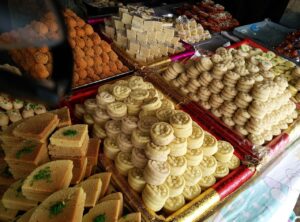 As key ingredients of sweets: The commonest classes of Indian non-meal sweets are:
As key ingredients of sweets: The commonest classes of Indian non-meal sweets are:
- Mawa/khoya (milk dried to a firm solid consistency) based, like pedhe, barfi, halwa, kaju katli, rabadi, gulab jamun, kala jamun etc.
- Flour-based like jalebi, laddu, ghevar, mohanthal, sutarfeni, son papadi etc.
In the first category, natural milk fat provides additional texture and richness. In the second, ghee (anhydrous milk fat) acts as a frying medium that becomes a part of the product and again provides texture and richness. (We routinely fry gulab jamuns in refined cottonseed oil where browning the balls, partial drying and creating pores/channels is the only requirement.)
Milk fat functionality is less prominent in Shrikhand (or Shikhand), kheers or porridges, rabadi and phirni because of the dominance of non-fat textures. The richness provided by milk fat coming in with milk, though less important, is still welcome. It is smart to exploit the fat-mimicking texture of gelatinized starch in porridges, kheers and phirni and reduce fat content. Try powdered, fine-sieved oats as substitute for custard powder, we already have.
In subji and daal making: This is a fascinating and familiar case. In India, subji’s and daals come in many versions so we will develop a general case that explains everything.
The mechanism: When oil is heated in a wok or karai, it becomes lighter and less viscous. There is intricate science and art in the stages at which spices are added to it but, generally whole mustard seeds and cumin seeds, the sturdy ones, are added first. Wet ingredients like onion, garlic, ginger, green chillies and tomatoes (if used) are added after these two, otherwise their water content will dampen the oil temperature and make crackling of dry whole spices difficult.


To cut a long story short, spices have two broad classes of spiciness constituents: volatile or not having significant charges on their molecules and relatively non-volatile or having charges on their molecules. The former want to go into oil and the latter into water – ‘like goes into like’. The spices added to hot oil lose some of their constituents into oil (partial extraction) i.e. the oil becomes somewhat spice-laden. At this stage, chopped subji is added to oil and the flash heating of water in the subji raises the well-known ‘chhumm’ sound. Some people prefer to add salt immediately to draw out water from the subjies by osmosis which aids cooking.
Stirring distributes spiced oil throughout. At some stage water is added to the wok to aid cooking (which has already started with water drawn out by osmosis) whereupon, some of the water-extractible constituents of spices move into it. So now you have (subji + spiced oil + spiced water + seasoning) simmering away. As water evaporates and cooking is complete, you end up with cooked subji intimately mixed with spiced oil and water, often so intimately mixed that you don’t see either. ‘Richer’ subjies with extra oil show free oil. Sometimes, continued cooking (especially of tomatoey ‘punjabi’ gravies) releases oil because of evaporation of extra water which can no longer hold oil in emulsion; chefs call it cooking till ‘oil is released’ or ‘oil separates out’.
Next Post:
Cooking with edible oils: Part II
Cooking thru oil-mediated heat transfer
Visit Disclaimer.
2 thoughts on “Cooking with edible oils: Part I, Oils as cooking ingredients and dish accompaniments”
Thanks for all your efforts that you have put in this. very interesting information.
That is very interesting, You are an overly skilled blogger. I have joined your rss feed and look ahead to searching for extra of your excellent post. Also, I’ve shared your site in my social networks!